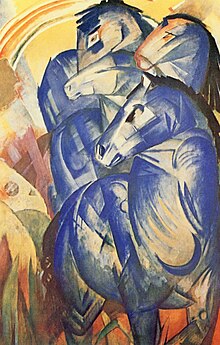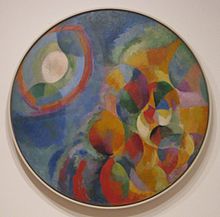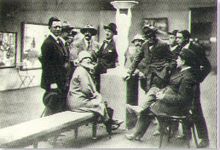First German Autumn Salon
First German Autumn Salon was the name of an art exhibition that Herwarth Walden held in Berlin in 1913 .
exhibition
The exhibition opened on September 20, 1913 in rented exhibition rooms (“Lepke Rooms”) at Potsdamer Strasse 75, at the corner of Pallasstrasse, third floor, on 1200 m², not far from Walden's gallery “ Der Sturm ” in Potsdamer Strasse 134a, and closed on December 1, 1913. The name of the exhibition was based on the Salon d'Automne that had been held in Paris since 1903 . The exhibition was a contrast to the Sonderbund exhibition , which had taken place in Cologne in 1912 and was more dedicated to the already established modernity of impressionism. In the autumn salon there were artists who had also been present there, but had not shown their advantage, such as painters of the Blue Rider , as well as Carlo Mense and Alexander Archipenko . The latter had already exhibited in the Autumn Salon in Paris. The (unnamed) patron Bernhard Koehler provided 4,000 marks for financial security, without which the exhibition would not have come about. August Macke and Franz Marc carried out the hanging. The painters of the Blauer Reiter group formed the main part of the exhibition. Marc himself also exhibited his programmatic painting The Tower of the Blue Horses .
In Germany there were forerunners in the exhibitions of the bridge from 1906 in Dresden and in the two exhibitions of the Blauer Reiter in 1911 and 1912 in Munich , which were then shown in various German cities. Walden took over the artists from the Futurism exhibition, which he opened on April 12, 1912 in his gallery “Der Sturm”. In the aftermath of the Futurist Exhibition and in the run-up to the Autumn Salon, the Prussian House of Representatives debated art on April 12, 1913. One MP ruled: "Because, gentlemen, we are dealing with a direction that is degenerate , a symptom of a sick time (loud applause)." However, the New York Times also had that spring for the Armory Show In 1913 he brought modern painting to New York, from which Alfred Stieglitz had acquired Kandinsky's Improvisation No. 27 for $ 500 and raised the "suspicion of pathology".
Due to the outbreak of the First World War , the autumn salon in Berlin could not be continued, so that no exhibition tradition developed under this name.
Preface
The exhibition catalog had a preface by the gallery owner Herwarth Walden and a preface by the exhibitors, penned by Franz Marc.
- “Today we do not live in a time when art is the helper of life. The real art that arises today seems more to be the precipitate of all forces that life cannot use up or absorb; it is the equation that abstractly minded spirits draw from life, desireless, purposeless and without strife ”.
- “In other times, art is the yeast that leaven the world's dough; such times are far off today. Until they are fulfilled, the artist must keep himself at the same distance from official life ”.
- “That is the reason for our self-chosen closure against the proposals that the world makes us; we don't want to mix with her. Under this »world« we also include artists who are alien to us and with whom it seems impossible to work together, not for 'art-political' reasons, which are so much talked about today, but for purely artistic reasons ”.
- "The exhibitors"
opening
Hans Richter was present at the opening: “So that was it! The Fauves! Picasso, Braque, the futurists. Marinetti read out his Futuristic Manifesto ! ”So Richter thinks he remembers, only: Picasso and Braques were not represented at Walden , presumably because of business ties to Paul Cassirer . Due to their ties to Cassirer or Flechtheim or to the Sonderbund, Macke, Marc and Walden, who had an intensive correspondence about this, were also able to use the Brücke painters as well as Max Beckmann , Lovis Corinth , André Derain , Max Liebermann , Henri Matisse , Edvard Munch , Waldemar Rösler and Karl Schmidt-Rottluff did not win, which they had at least considered.
In the First German Autumn Salon, exhibits from an international avant-garde , artists from America, Germany, Holland, Austria, France, Italy, Russia and Switzerland came together. Walden wanted to provide an overview of the arts around the world. Among them, the Italian futurists had a concentrated appearance with a total of fourteen works by Giacomo Balla, Umberto Boccioni, Carlo Carrà, Luigi Russolo, Gino Severini and Ardengo Soffici. Fernand Léger had fifteen works. Of the artists associated with the Blauer Reiter, Paul Klee was represented with 22 watercolors and drawings, Wassily Kandinsky with seven pictures, Marianne von Werefkin with three, Alexej von Jawlensky with four, Alfred Kubin with 19, Gabriele Münter with six works. Robert Delaunay and his wife Sonja had painted a series of oil paintings of sun and moonlight in Louveciennes in the summer of 1913 , which here made up a large part of his 21 works, with which Orphism also influenced Macke and Marc, while Sonja was among hers alongside these paintings 26 objects also had book covers, lamps and towels. Marc was able to lure Lyonel Feininger out of the self-chosen "being unknown", Kubin had arranged the contact.
Adolf Behne made the first tour of the exhibition for the visitors .
Henri Rousseau memorial exhibition
The memorial exhibition for Henri Rousseau , in memory of the painter who died in 1910, had a special position in the exhibition, with 21 works and a pen drawing - only the drawing was for sale . Most of these pictures came from Wilhelm Uhde and from the collection of Robert Delaunay, who was something like the administrator of the estate for Rousseau. Delaunay made twelve works, including the two portraits. For Paul Westheim in the Frankfurter Zeitung , this was the part of the exhibition “that could be enjoyed without footnotes”.
polemic
When the First German Autumn Salon opened its doors in September 1913, it received bad reviews. In the press there was talk that here "the talentless are lined up in rank and file". Robert Breuer referred to the artist in Vorwärts as "Hottentots in a shirt, a horde of color-splashing howler monkeys". Herwarth Walden had to put up with being described as an "incompetent academic, arrogant theorist, multicolored booby and bastard talent". For the critic Emanuel des Simplicissimus, “In the new futuristic-cubist-psychopathic-neopathological Berlin autumn salon” there was not only “a futurist portrait whose main attraction is a glued-on mustache on glued-on hair”, “which comes from futuristic brushes”. This was the portrait of Gino Severini by Marinetti. But also the “excrement of an insane cow” by Signor l'Asino, which is to be countered with the means of excremental psychology. Karl Scheffler , who was apostrophized by Ludwig Justi as the “art pope” , also turned against Severini's hair collages. Walden countered with pointed remarks in his "Preface" to the exhibition catalog and with a dictionary of German art criticism. Compiled from newspaper reports about the autumn salon , which he brought to the people as a leaflet : He quoted these from “Anödung des Audiences” to “Negroes in tails” and “Malbotokuden” to “Picture gallery of a madhouse”, and it ended with "And so on".
Exhibition catalog
In the exhibition catalog, a total of 90 artists, painters, sculptors and architects were named, with 366 pictures, designs and sculptures. The catalog contained 50 reproductions of exhibited works, however
“[The catalog] gives no picture at all and is weak in many ways; a number of pictures that have been reproduced in it were not hung by us at all. Walden put it together in advance based on the photos sent in; the exhibition itself was basically something completely different. Anyway these boring photographs! "
Artists represented with images in the catalog


- Hans Arp
- Giacomo Balla
- Willi Baumeister
- Vincenc Beneš
- Albert Bloch
- Umberto Boccioni
- Hanns Bolz
- Patrick Henry Bruce
- Heinrich Campendonk
- Carlo D. Carra
- Marc Chagall
- Robert Delaunay
- Elisabeth Ivanovna Epstein
- Max Ernst
- Lyonel Feininger
- Emil Filla
- Ugo Giannattasio
- Natalie Gontscharoff
- Otto Gutfreund
- Walter Helbig
- Hermann Huber
- Alexej von Jawlensky
- Wassily Kandinsky
- Paul Klee
- Alfred Kubin
- Nikolai Ivanovich Kulbin
- Reinhold Kündig
- Michael Larionoff
- Fernand Leger
- August Macke
- Franz Marc
- Carl Mense
- Gabriele Münter
- Francis Picabia
- Albert A. Plasschaert
- A. Prochazka
- Adriana van Rees-Dutilh
- Otto van Rees
- Luigi Russolo
- Ludwig Schelfhout
- Paul Adolf Seehaus
- Richard Seewald
- Gino Severini
- Jan Sluyters
- Ardengo Soffici
- Amadeo de Souza-Cardoso
- Stanislas piece gold
- Hans Thuar
- Marianne von Werefkin
Other artists exhibited according to the catalog
- Egon Adler
- Alexander Archipenko
- Fritz Baumann
- Vladimir Georgievich Bechtejew
- David Burljuk
- Vladimir Burlyuk
- Gordon M. Mac Chouch
- Sonia Delaunay-Terk
- Heinrich Ehmsen
- Léo Gestel
- Albert Gleizes
- Gocar
- Marsden Hartley
- Jacoba van Heemskerck
- Franz Henseler
- George Jacouloff
- Pavel Janák
- Oskar Kokoschka
- Josef Koelschbach
- Adrian Johan Korteweg
- Otakar Kubin
- Alfred Loeb
- Helmuth Macke
- Louis Marcoussis
- Corrado-Alberto Mazzei
- Jean Metzinger
- Alexander Mogilewsky
- Louis Moilliet
- Piet Mondrian
- Ernst Sonderegger
- Jakob Steinhardt
- Curt Stoermer
- Charles de Tholey
- Erich Wichmann
- Ortiz de Zarate
- As well as unsaleable Russian, Indian, Turkish, Japanese and Chinese paintings from the possession of Marc and Kandinsky
literature
- First German Autumn Salon: Berlin 1913 / Head: Herwarth Walden , Nachdr. [D. Ed.], Galerie Der Sturm, Berlin 1913, ISBN 3-88375-082-4 dnb
- Digitized copy of the Solomon R. Guggenheim Museum Library in the Internet Archive
- Andreas Hüneke (ed.), The blue rider: Documents of a spiritual movement . Afterword by Andreas Hüneke, Leipzig: Reclam 1986 DNB
- Peter Selz : “The First German Autumn Salon. Berlin 1913 ”, in: Bernd Klüser, Katharina Hegewisch (ed.): The art of the exhibition. A documentation of thirty exemplary art exhibitions of this century . Insel Verlag, Frankfurt a. M. / Leipzig 1991, ISBN 3-458-16203-8 , pp. 56-63
- Gerd Presler : A man sows storms , in: art - Das Kunstmagazin , 2/2003 [1]
- Berliner Festspiele , Languages of Futurism , October 2, 2009 to January 11, 2010, exhibition catalog ISBN 978-3-86859-066-1 ; therein Ursula Prinz, futurist in Berlin. Also: PDF
- Götz Adriani : Exhibition Henri Rousseau, the customs officer - border crosser to modernity , 2001, Tübingen; Kunsthalle Tübingen , DuMont, Cologne 2001, ISBN 3-7701-5591-2
- Karla Bilang : "Artists of the First German Autumn Salon", in: dies .: Women in the STURM. Modern artists . AvivA Verlag, Berlin 2013, ISBN 978-3-932338-57-1 , pp. 23–86
Web links
- First German Autumn Salon (partial edition of the catalog)
- Exhibition directory [2]
Individual evidence
- ↑ after the house numbering was changed in 1936, today No. 180. Marc describes the rooms as "Lepke rooms" ( Rudolph Lepke ), Marc to Kandinsky, April 2, 1913, in: Andreas Hüneke : Der Blaue Reiter , p. 465 .
- ↑ Max Nordau invented the term in 1892 with great consequences
- ↑ a b Presler: A man sows storm
- ↑ Walden had shown the picture in his gallery in 1912
- ^ Exhibition catalog p. 9
- ↑ Also without illustration in the catalog: Robert Delaunay, Soleil Lune Simultané 2 , exhibition catalog # 87
- ↑ quoted in: Ursula Prinz: Futuristen in Berlin , p. 47
- ↑ Peter Selz, p. 60
- ↑ these other names can be found in the correspondence. Excerpts from this at: Andreas Hüneke: Der Blaue Reiter , pp. 463–489
- ↑ Christopher Green: Légers Contrasts and the Parisian Avant-garde 1913–1914 , in: Fernand Léger: 1881–1955; e. Exhibition at the Staatliche Kunsthalle Berlin, October 23–7. January 1980, pp. 83f
- ↑ Feininger to Marc, July 18, 1913, in: Andreas Hüneke: Der Blaue Reiter , p. 470
- ^ Adolf Behne, "Der Erste Deutsche Herbstsalon", excerpts from: Andreas Hüneke: Der Blaue Reiter , p. 480
- ^ Adriani: Exhibition Henri Rousseau , pp. 221–223
- ↑ Exhibition catalog # 324, illustration by Prinz
- ^ "Emanuel" (d. I. Peter Scher ): Berliner Kunstprobleme , in: Simplicissimus , No. 28, 1913, p. 450.
- ↑ Selz, p. 62
- ↑ in Andreas Hüneke: Der Blaue Reiter , p. 474
- ↑ The sculpture is lost. The picture of the sculpture has no catalog number. In the list of the exhibition catalog were these three pieces by Boccioni: # 52 Ascending Plastic Movement; # 53 Dissolution of people at the table; # 54 elasticity













